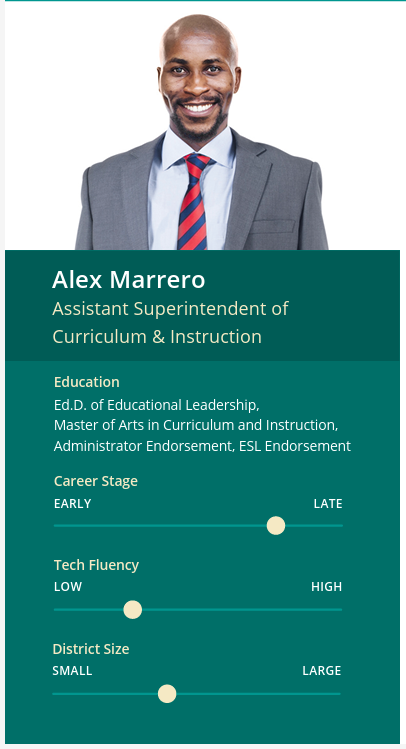A Day in the Life of a Curriculum Director
Date
What you need to know about the challenges of curriculum leaders in navigating adoption and implementation to achieve a school district’s instructional goals.
If you want to see your product or service used regularly in classrooms, understanding the daily workflow of a curriculum director is key. As a school district’s primary administrator responsible for deciding on instructional materials and practices, these leaders juggle competing priorities, vet new solutions, and ensure that curricula align with the strategic instructional goals of their district. Their influence shapes purchasing decisions and long-term adoption.
Alex Marrero, an Assistant Superintendent of Curriculum and Instruction, is one of our education market personas, a representative compilation of common roles in K-12 education based on interviews and experiences from the last two decades. Let’s follow Alex as he manages the complexities of innovation, collaboration, and instructional leadership.
Navigating Daily Challenges

Alex’s job isn’t just about selecting textbooks or overseeing professional development. It’s about ensuring that every decision aligns with student needs, educator growth, and the district’s broader vision for learning. With responsibilities ranging from managing educator evaluation to overseeing new educator onboarding and mentorship, Alex's role encompasses a wide range of instructional leadership.
A typical day might start with a department team meeting, where he collaborates with TOSAs (Teachers on Special Assignment) and instructional coaches to evaluate new digital tools to support computer science instruction across the district’s middle and high schools. While some schools already offer a computer science program, others need additional support. His team discusses training needs, alignment with state standards and graduation profiles, and equitable implementation.
Key Insight: Adoption success requires a deep understanding of a district's existing structures and priorities. Implementation strategies, professional learning, and a clear product strategy are critical for scaling district-wide. We help clients bridge this gap, making products become instructional assets rather than an occasional tool.
Working across Stakeholders
Curriculum Directors like Alex often meet with building principals to discuss instructional issues and professional learning. Today’s meeting reveals another pressing issue—several principals report that educators are feeling overwhelmed by the influx of new curricular programs and initiatives. He reassures the principals that his team will collaborate with building-level instructional coaches to come up with a plan to ensure smooth implementation without adding unnecessary burden. After his meeting, he reviews a few approaches he’s seen implemented elsewhere and settles on launching an on-demand microcredential program, giving educators the flexibility to personalize their professional learning.
Key Insight: Edtech adoption isn’t just about getting leadership buy-in—it’s about making implementation seamless for educators. Professional learning needs to be flexible, relevant, and integrated into educators’ workflows. Our clients rely on our expertise to tailor their implementation strategies and materials to fit real-world school environments, making it easier for curriculum directors like Alex to say yes.
Screening and Piloting New Solutions
Increasingly, Curriculum Directors lead the assessment of new instructional tools for their district, often in partnership with the district’s Director of Technology. A major part of Alex’s afternoon is reviewing and evaluating edtech solutions, assessing whether they align with instructional priorities and fit within the district’s budget constraints. Today, he’s considering an AI-powered formative assessment tool. After reviewing the latest research on best practices for formative assessment, he speaks with the district’s assessment and data analysis team about data privacy concerns and schedules a meeting with the educators piloting the tool over the last six weeks to collect their feedback.
Key Insight: Understanding a district’s evaluation process and criteria is critical to ensuring adoption. Without clear data on usage and efficacy, strong privacy protections, and sustained training and support, even a promising product may struggle to gain traction. We help companies refine their approach to better meet district expectations.
The Balancing Act
By the end of a typically long day, Alex reflects on the countless decisions, emails, conversations, meetings, and to-dos that shape his day. Balancing instructional support needs, educator capacity and growth, and identifying and implementing initiatives that achieve the district’s strategic plan isn’t easy for Curriculum Directors. But by maintaining a student-first mindset, fostering strong relationships with principals and educators, and using data to drive decisions, Alex knows that every initiative—whether a new curriculum, a professional learning program, or an edtech adoption—will benefit the students and staff he serves.
Key Insight: Measuring success in K-12 education isn’t just about having a great product that sells—it’s about understanding how to support adoption and digital pedagogy, and tailoring your solution to help achieve district strategic priorities. This is the kind of work we’ve done for nearly three decades.
As you can see, a typical Curriculum Director like Alex leads and coordinates all aspects of curriculum, instruction, and assessment across a school district, ensuring alignment with strategic goals and equity initiatives. For more details about the responsibilities of the role, we invite you to browse the two-page profile in Clarity’s education market personas. If you’re interested in improving the adoption and engagement of your product or service in the classroom, try out Engagement Booster Packs.

